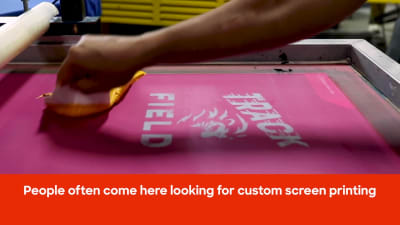Detailed Silk Screen Printing for Custom Art Apparel
Detailed Silk Screen Printing for Custom Art Apparel
Blog Article
Discovering the Art of Display Printing: A Comprehensive Overview to T-Shirt Printing Methods
When you tip right into the globe of display printing, you're getting in a domain name where creative thinking fulfills craftsmanship. It's not practically slapping ink on textile; it's a precise process that needs the right devices and strategies. As you discover various approaches, you'll find how to create attractive t-shirt designs that stand apart. What are the essential components you need to understand before you can truly make your mark?
The Essentials of Screen Printing: Recognizing the Refine
Screen printing, often called serigraphy, is a flexible strategy that allows you to transfer styles onto numerous surfaces. To begin, you'll initially require to create a stencil, which offers as the foundation for your style. This involves applying a light-sensitive solution to a display and exposing it to light, where your art work obstructs the light from hardening the emulsion.
As soon as you have actually washed out the unexposed areas, you'll have a stencil prepared for printing. Next, you put the display on your picked surface area, like textile or paper. You then apply ink on top of the display and make use of a squeegee to push the ink with the pattern onto the surface area below. After printing, you'll need to cure the ink to ensure it adheres appropriately. Comprehending these fundamental steps sets the phase for developing vivid, lasting layouts with the art of screen printing.
Important Devices and Products for Display Printing
To start with display printing, you'll need some essential devices and products. From the right tools to the inks and emulsions that bring your styles to life, each aspect plays an essential function. Let's explore what you require to be successful in this imaginative process.
Screen Printing Devices
While diving into the world of screen printing, you'll find that having the appropriate devices is important for achieving top quality results. Begin with a strong screen printing frame, which holds the mesh that transfers ink onto your textile. You'll additionally require a squeegee for pushing the ink with the mesh. A good high quality direct exposure device is vital for developing sharp styles when subjecting your displays. Don't neglect a washout station for cleansing your screens after printing. Additionally, safety gear like handwear covers and masks is essential for your safety and security. Ultimately, purchase a reputable heat resource, such as a warmth press or conveyor clothes dryer, to treat your prints successfully. With these tools, you're well on your method to mastering display printing!
Inks and Solutions
Choosing the ideal inks and emulsions is crucial for achieving durable and vibrant prints. You'll desire to pick inks based upon your preferred coating and fabric kind. t-shirt printing. Plastisol inks are preferred for their ease of usage and terrific opacity, while water-based inks offer a softer feel and are extra ecologically pleasant
Emulsions act as a light-sensitive layer on your displays, critical for developing sharp stencils. Ensure to pick a high-grade emulsion that matches your ink type; some solutions work much better with plastisol, while others are perfect for water-based inks. Correct curing is also necessary; it ensures the ink adheres well and stands up to washing. By buying the right inks and emulsions, you'll raise your display printing game considerably.

Devices for Application
You'll need a strong screen, ideally made of aluminum or wooden frames, along with a fine mesh for appropriate ink transfer. A squeegee is essential for applying pressure and spreading ink uniformly throughout the display. With these tools, you'll be fully equipped for effective screen printing!
Typical Display Printing Strategies
Typical display printing techniques have actually stood the examination of time, showcasing the art and craftsmanship behind this preferred approach. You'll usually start with a stencil made from a great mesh material extended over a structure. This mesh permits ink to pass through while obstructing locations you intend to stay unprinted. As soon as you've prepared your layout, you'll use a light-sensitive solution to the screen and expose it to a light, setting the emulsion where you desire ink to circulation.
After washing out the unexposed emulsion, you're left with a stencil. You'll after that place your screen on the tee shirt, use ink ahead, and utilize a squeegee to push the ink via the mesh. This process can be repeated for multiple shades, requiring separate screens for each and every. The outcome? Dynamic, sturdy layouts that display your imagination. Grasping these methods offers you a solid structure for all your screen printing ventures.
Modern Innovations in Tee Shirt Printing
Today's t-shirt printing landscape is humming with interesting developments that are transforming exactly how you create styles. With improvements in digital printing, eco-friendly materials, and advanced modification modern technologies, you can create unique, sustainable t shirts like never ever before. Let's explore these contemporary techniques and see how they improve your printing experience.
Digital Printing Innovations
As electronic printing technology has advanced, it's transformed the landscape of Tee shirts printing, offering you unmatched accuracy and imagination. Direct-to-garment (DTG) printing enables you to print straight onto material, making it suitable for little runs or custom styles. With innovations in ink quality, you can expect toughness and washability that matches display printing.
Eco-Friendly Materials Use
While checking out contemporary advancements in Tee shirts printing, you'll uncover an expanding focus on green materials that prioritize sustainability without compromising top quality. Numerous brands now use natural cotton, which decreases pesticide usage and promotes healthier farming techniques. Recycled polyester, made from plastic bottles, offers a long lasting option that reduces waste. Additionally, water-based inks are getting appeal, as they create less unsafe overflow contrasted to standard solvent-based inks. These inks are t-shirt printing not just much safer for the environment yet likewise provide vibrant colors and soft structures on fabric. By selecting these products, you add to a more lasting fashion business while still enjoying stylish, top quality Tee shirts. Embracing green alternatives enables you to share your values with your closet.

Personalization Technologies Advancement
You currently have accessibility to digital printing methods like Direct-to-Garment (DTG) and Dye-Sublimation, which allow for dazzling shades and complex styles. These developments make it simple to produce one-of-a-kind pieces without the high prices of traditional display printing. Additionally, on the internet design systems equip you to imagine your concepts before printing.
Choosing the Right Ink for Your Designs
How do you choose the ideal ink for your screen printing styles? If you're printing on artificial products, plastisol inks supply durability and dynamic shades.
Next, believe regarding the finish you desire. Matte inks provide a subtle look, while glossy inks can include a striking shine. If you're aiming for eco-friendliness, choose water-based or soy-based inks, which are better for the environment.
Do not forget color mixing; some inks can be blended to create special tones. Test your inks on sample textiles to confirm compatibility and look before starting your primary project. Inevitably, the appropriate ink can make a substantial distinction in the top quality and durability of your styles, so pick sensibly!
Tips for Creating Stunning T-Shirt Designs
Creating sensational tee styles begins with a clear principle that reverberates with your target market. Assume regarding what themes or messages will certainly link with them mentally. Use attractive graphics and bold shades to grab attention. Remember, simpleness often functions best; messy styles can puzzle viewers.
Integrate typography that mirrors the personality of your brand-- select typefaces that are readable yet stylish, and mix them wisely. Focus on positioning; the design must flow normally with the t-shirt's shape.
Explore various styles, such as vintage or modern-day, to find what fits finest. Don't shy away from using adverse area effectively; it can produce a striking visual impact.
Last but not least, get feedback! Share your designs with pals or possible clients to determine their responses (t-shirt printing). Their understandings can guide you in refining your job, guaranteeing your last design is not only spectacular but additionally market-ready
Repairing Usual Display Printing Difficulties
When you encounter challenges in screen printing, determining the source can make all the distinction. Check your screen for correct tension and confirm your emulsion is completely cured if you notice incomplete prints. For smearing or blurred pictures, maybe as a result of improper ink thickness or not enough curing time; readjust your ink or treatment settings accordingly.
If you're handling shade mismatches, confirm your ink blending ratios and confirm your screens are cost-free and tidy of residue.
Lastly, if you're experiencing training or peeling, consider the sort of fabric you're making use of and the warm used during treating; various materials require details inks and temperatures. By dealing with these usual issues carefully, you'll boost your results and increase your confidence in display printing. Keep trying out, and don't wait to connect to fellow printers for tips and guidance.
Frequently Asked Inquiries
Can I Evaluate Print on Textile Besides T-Shirts?
Definitely, you can evaluate print on different fabrics besides tees! Take into consideration products like tote, hoodies, or also tablecloths. Simply guarantee you're making use of the appropriate ink and devices appropriate for the fabric kind.
How Do I Clean and Keep My Screen Printing Equipment?
To clean and maintain your screen printing equipment, consistently wash screens with water and ideal cleaners, check mops for damages, and store whatever in a dry, dust-free atmosphere to lengthen its life expectancy and guarantee quality prints.
What Is the Average Price of Beginning a Screen Printing Company?
Starting a display printing service typically sets you back in between $2,000 and $10,000. You'll require tools, products, and a work space. It's crucial to spending plan carefully and plan for added expenses as your business grows.
Is Screen Printing Eco-friendly?
If you pick eco-conscious inks and lasting materials,Screen printing can be environmentally pleasant. By embracing ideal techniques and minimizing waste, you can minimize your impact while producing vivid, high-quality prints that attract conscious customers.
How Can I Promote My Personalized Tee Layouts Efficiently?
To promote your custom tee shirt layouts effectively, take advantage of social networks platforms, team up with influencers, run targeted advertisements, and involve your audience with giveaways or competitions. Consistent branding and high quality visuals will certainly attract even more consumers.
Exploring the Art of Display Printing: A Comprehensive Overview to Tee Printing Techniques
Begin with a sturdy screen printing structure, which holds the mesh that moves ink onto your fabric. By spending in the best inks and solutions, you'll raise your display printing game considerably.
With improvements in ink high quality, you can anticipate sturdiness and washability that matches display printing.How do you pick the right ink for your display printing layouts?
Report this page